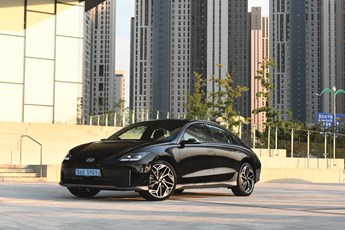We use cookies to ensure that we give you the best experience on our website. If you continue without changing your settings, we will assume that you are happy to receive all cookies on the Business Car website. However, if you would like to, you can change your cookies at any time

The start point for the best source of fleet information |
First drive: Hyundai Ioniq 6
Date: 08 November 2022 | Author: David White

|
|
||||||||||||||||
No longer content with just being competitive, Hyundai has rightly become confident enough in its products to do its own thing aesthetically, and especially with electric vehicles. In an increasingly SUV-shaped plug-in market, the Ioniq 6 is an ultra-aerodynamic saloon with the Tesla Model 3 and Polestar 2 in its sights. It's the result of a development programme focused on maximising efficiency and range, and an interesting option for sustainability-minded fleets.
This is a deceptively large car; almost identical in length, width and height to the Volkswagen Arteon and sharing its modular EV-only platform with the SUV-like Ioniq 5. Hyundai hasn't confirmed the UK line-up yet, but there are two battery options (53kWh and 77.4kWh) each with a motor at the rear axle, and an optional front motor for the larger pack. The majority of Ioniq 5 customers have opted for the longest range, and there's no reason this won't follow suit. Rival pricing suggests 77kWh versions will start at around £45,000, or £50,000 with the all-wheel drive system.
The tapered silhouette - with its flat under-floor panels, flush door handles and optional camera-based side mirrors - makes much better use of the otherwise unmodified powertrain. An Ioniq 5 with the 77kWh battery option, two-wheel drive and 20-inch wheels travels roughly 3.4 miles per kilowatt-hour with a range of 295 miles. That compares to 3.9MPkWh and 339 miles of range in the Ioniq 6, or roughly a 12% reduction in charging bills. With the 53kWh battery and 18-inch wheels, and it's more efficient than the much smaller Kona Electric crossover.
We tested the car with the long-range battery, dual-motor powertrain and 20in wheels that UK customers are most likely to opt for. It's the most potent model in the line-up, producing 325hp and reaching 62mph in 5.1 seconds from rest, but feels more of a long-distance cruiser than a sports saloon. There's a useful surge of power for overtaking, especially in the sportiest drive modes selected on the steering wheel's thumb control, but it's metered out smoothly. The large wheels do little to blunt the ride quality, its low-slung battery offers confident handling, and the aerodynamically and acoustically optimised body means it's almost silent at motorway speeds.
The 228hp rear-wheel drive version is arguably a better fit for fleets, but drivers who need the extra traction don't lose much in terms of efficiency. There are four stages of progressively more aggressive regenerative braking to capture otherwise-wasted energy, though the car can do this automatically too, and the front motor can decouple itself from the wheels to reduce drag. Our test car returned almost 4.0MPkWh over a mix of roads and driving modes with the climate control switched on, which is more efficient than a lot of smaller EVs. Gentle drivers should be able to coax even more out of it.
Regardless of driving style, the range available here means comfort breaks will be more frequent than charge stops. The Ioniq 6 will charge from 10% to 80% in 18 minutes on the fastest 350kW chargepoints, which equates to more than 200 miles of extra range. It charges quickly enough that you'll barely have time to plug a laptop into the power outlet beneath the rear seats, or use the flat centre console as a desk, but it's good to know Hyundai has considered driver productivity while topping up.
Dynamics aside, the platform offered opportunities for clever packaging. The cabin floor is completely flat, the wheelbase is longer than similarly sized combustion engine cars, and the roofline isn't as low as it appears. Its plush, eco-friendly materials and 64-colour ambient lighting feel as upmarket as premium-brand EVs, and the slimline front seats are supportive over long distances. There are downsides, though. Rear passengers get lots of legroom but with shallow footwells and limited headroom due to the tapered roofline, and boot access would have been easier with a hatchback. The boot is tunnel-like with a narrow opening, but can be extended by folding the rear bench.
On-board technology impresses, too. The Ioniq 6 uses the same clear and intuitive driver display and infotainment system as the 5, both comprehensively packed full of useful features while also being easy to operate at a glance. Android Auto and Apple CarPlay are both included and the built-in navigation includes live traffic and safety camera data with speed warnings relayed through the ambient lighting. Aerodynamic camera-based mirrors will be available in the UK, with screens logically positioned on winglets at each end of the dashboard, while useful blind spot displays pop up in the instrument cluster while indicating.
This stacks up a complementary stablemate for the popular Ioniq 5. Distinctive even within its own range, it's a credible alternative to the familiar fleet-friendly saloons with energy efficiency that belies its size. Good reasons for Hyundai to feel confident about not following the crowd.
Hyundai Ioniq 6 77.4kWh AWD
P11D: TBC
On sale: November
Cost per mile: TBC
Range: 322 miles
CO2 (BIK %): 0g/km (2%)
BIK 20/40% a month: TBC
Battery size/power: 77.4kWh/325hp
Verdict |
8/10 |
|||
 |
|
 |
|
|











